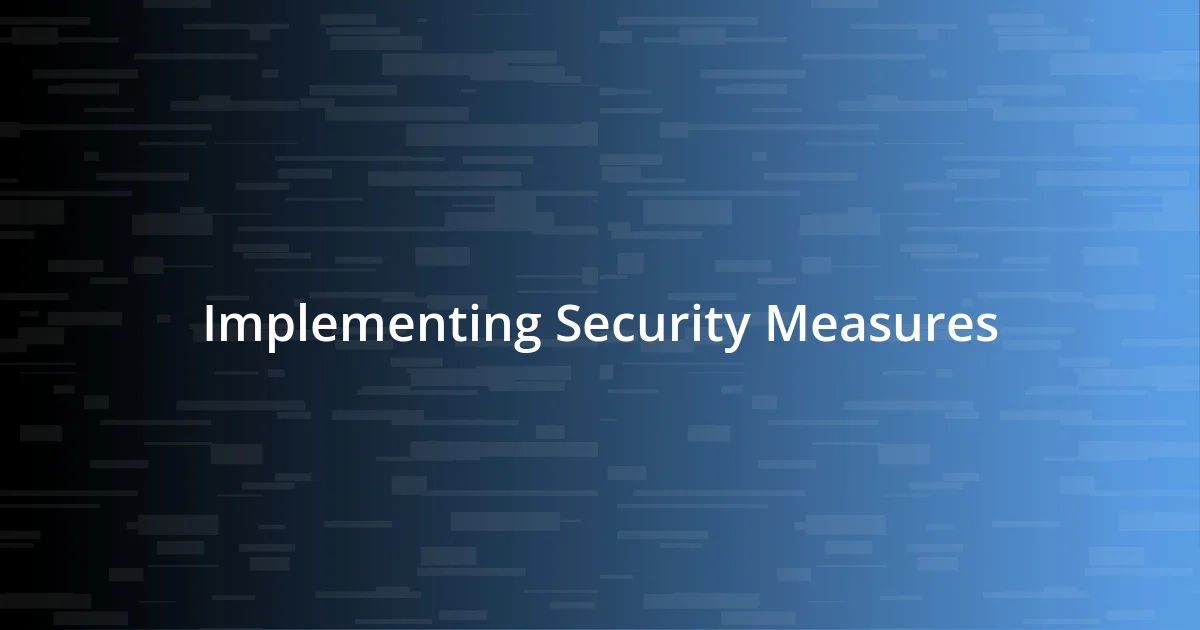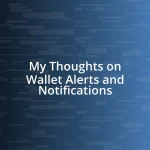Key takeaways:
- Awareness of wallet threats, such as phishing and social engineering, is crucial for maintaining security; emotional vulnerability and haste can increase susceptibility.
- Identifying potential risks involves verifying sources of information and being cautious about personal data shared online.
- Engaging with reliable resources, the community, and implementing security measures like two-factor authentication are essential steps in protecting digital wallets.

Understanding Wallet Threats
When I first started using digital wallets, I was blissfully unaware of the types of threats that lurked online. I remember the uneasy sensation that washed over me when a friend shared her tale about losing access to her funds due to a phishing scam. The reality is, wallet threats can manifest in various forms, from malware attacks to social engineering tactics that prey on our trust.
One common threat is the rise of phishing schemes, which can look alarmingly genuine. I’ve often found myself questioning the authenticity of certain emails or messages, even from companies I trust. How can we differentiate between a legitimate request for information and a potential scam? This uncertainty keeps me on high alert, always double-checking URLs and scrutinizing sender details.
It’s not just about technology; emotional vulnerability plays a big role too. For example, I’ve caught myself rushing through digital transactions during a busy day, only to realize later how my distraction left me susceptible to threats. I often wonder: are we too hasty in our digital lives? These experiences have taught me that being informed and vigilant is crucial to maintaining my digital wallet’s security.

Identifying Potential Risks
Identifying potential risks while using digital wallets requires a keen eye for detail and an awareness of common threats. I’ve learned to recognize the signs of suspicious behavior, particularly when it comes to unexpected requests for personal information. Like the time I received a message claiming my wallet needed an urgent update, only to discover later that it was simply a ploy to steal my information. This incident taught me the importance of verifying sources before acting on any information.
Another risk I often encounter is the role of social media in wallet vulnerabilities. There have been moments when I’ve shared a little too much about my transactions or financial habits online, prompting unsolicited messages from unknown users. I’ve become increasingly cautious about what I share, realizing that even seemingly harmless posts can attract unwanted attention from scammers looking for easy targets.
I’ve also come to understand the significance of secure connections when I’m accessing my wallet. Once, I connected to a public Wi-Fi network at a café, thinking it was no big deal. However, I soon learned about the dangers of such connections when my banking app showed unusual log-in attempts. This experience was a wake-up call for me, reminding me how essential it is to use secure connections, like a VPN, to protect my financial information.
| Risk Type | Example |
|---|---|
| Phishing | Urgent request for wallet update |
| Social Engineering | Unsolicited messages after oversharing |
| Network Vulnerability | Public Wi-Fi leading to hacking attempts |

Reliable Information Sources
Finding reliable information sources is paramount in staying informed about wallet threats. I often turn to official resources, like the websites of my digital wallet providers. That way, I know I’m getting accurate information directly from the source. Additionally, I keep an eye on cybersecurity blogs and forums where experts share real-time updates and tactics to counter emerging threats.
Here are some of my go-to sources:
- Official Wallet Websites: Direct information about updates and security measures.
- Cybersecurity Blogs: Insightful articles that explain new threats and preventive measures.
- Forums and Communities: Real user experiences and tips that can be very realistic and relatable.
- Governmental Cybersecurity Agencies: Trusted information on scams and protective legislation.
- Social Media Channels of Security Experts: Quick updates and alerts about recent developments in wallet security.
Staying connected with these sources not only helps me stay informed but also fosters a sense of community, where I feel I’m not alone in navigating this complex digital landscape.

Analyzing Threat Intelligence
Analyzing threat intelligence involves parsing through a mountain of data to find insights that genuinely matter. I remember the time I stumbled upon a cybersecurity newsletter that discussed recent trends in wallet hacking. It highlighted suspicious transactions linked to unprecedented phishing campaigns. This analysis made me realize the sheer volume of threats that can exist simultaneously and underscored the necessity of sifting through the noise to focus on what’s pressing.
When I analyze threat intelligence, I often consider the context surrounding each threat. For example, there was a period when I noticed a spike in reports about fake wallet apps. It made me wonder, how did these scams become so prevalent overnight? This reflection prompted me to dig deeper, comparing various reports and finding that many had common origins. Evaluating such patterns helps me anticipate potential risks and stay a step ahead.
Engaging with threat intelligence doesn’t just mean reading reports; it’s about understanding their implications for my digital safety. A few weeks ago, I encountered an article that connected data breaches to increased wallet threats. I felt a mix of frustration and urgency as I read through the implications—such intelligence can lead to tangible preventative measures, like changing passwords or enhancing two-factor authentication. How can one ignore the necessity of adapting and evolving with these threats? It drives home the point that staying informed is not just a choice; it’s essential for safeguarding our digital lives.

Implementing Security Measures
Implementing robust security measures is something I take very seriously. I remember one instance when I set up two-factor authentication (2FA) on my wallet after reading about a significant uptick in unauthorized access attempts. That single action not only added an extra layer of protection but also gave me peace of mind, knowing I was doing my part to safeguard my assets. Have you considered what steps you’re taking to secure your wallet?
Another security measure I’ve found invaluable is regularly updating my passwords and using a password manager. A while back, I faced a scare when I received an alert about a possible breach involving one of my accounts. I took immediate action, changing my passwords across the board. It made me realize how critical it is to have unique, strong passwords for each account. This slight inconvenience could potentially prevent a major headache down the line.
I also make it a habit to review security settings frequently. Once, I noticed a new option for biometric login on my wallet application. I don’t know about you, but enabling fingerprint recognition felt like a game-changer for me—it’s quick and adds that extra layer of convenience while keeping my information safe. Are your security settings up-to-date, too? Taking a few minutes can make a world of difference in securing your digital assets.

Staying Updated Regularly
Staying updated regularly about wallet threats is something I prioritize in my routine. I’ve made it a habit to subscribe to several reputable cybersecurity blogs and forums. The other day, while scanning through one of these sites, I came across an alert regarding a new malware targeting wallet users. It struck me how quickly threats can evolve, and this reminder nudged me to check my own security settings.
I also make it a point to follow influential experts on social media. Recently, I saw a tweet about a fraudulent email campaign pretending to be from a popular wallet provider. The urgency in the author’s tone resonated with me—I could almost feel the fear of those who might fall victim to such scams. Engaging with real-time updates like this helps me grasp the scope of potential risks while fostering a sense of community among fellow users.
Additionally, I set aside time each week to review security podcasts and webinars. I recall tuning into a session that featured a discussion on maintaining wallet security practices. They shared actionable insights about recognizing phishing attempts that I’ve since incorporated into my daily habits. It’s amazing how investing just a little time can empower us to stay ahead of these threats; have you found a method that works well for you?

Engaging with the Community
Engaging with the community around wallet security has opened my eyes to new threats and solutions. I often join local cybersecurity meetups where enthusiasts and professionals exchange ideas and experiences. I remember attending one where someone shared a harrowing story about losing access to their crypto wallet; the fear and vulnerability in their voice reminded me of just how important it is to stay connected and informed.
Online forums are another great space for collaboration and awareness. Just recently, I participated in a discussion thread about protecting wallets from phishing scams. As I read through various responses, it hit me how collective knowledge can significantly enhance our strategies. Have you ever felt that moment of realization when someone shares a tip that could change the way you approach security?
Moreover, I routinely engage with user groups on platforms like Reddit or Discord. One day, a fellow member posted about two-factor authentication methods, detailing how they recovered from a close call with a wallet hack. That personal account ignited a deep sense of responsibility in me to continuously educate myself, and it made me wonder—what if we all shared our experiences? Wouldn’t we all become stronger together in this fight against wallet threats?














